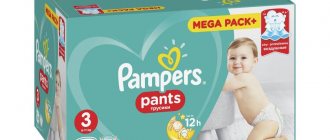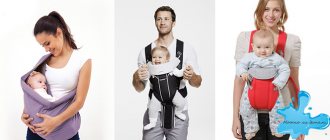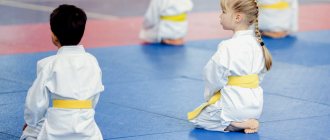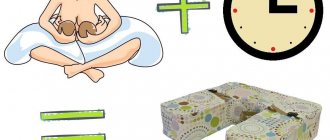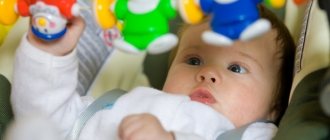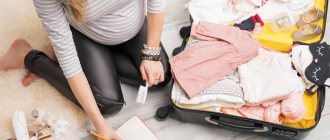DISPOSABLE DIAPERS (DIS) OR PAMPERS were invented in 1957 by leading chemist-technologist Victor Mills and launched into mass production in 1959. The essence of Mills's invention was dictated by the most ordinary egoism, the desire to make life easier for oneself, and not to improve the lives of children, who, apparently, were doing well anyway. The main ideological postulate of the general theory of the use of disposable diapers:
«A child doesn’t need diapers, those who care for that child need diapers!”
DISPOSABLE DIAPERS
PROS:
- Convenient for those caring for a child, freeing up their time;
- Relieves you from daily laundry, nightly getting up, worries while walking;
- A good disposable diaper always keeps you dry – even when it’s gone “big”;
- Provides “wide swaddling”
MINUSES:
- OP the thing is not cheap. Over two years of use, you will have to spend about 1.5 thousand dollars on diapers. It makes you want to save money, which often happens to the detriment of hygiene and health.
- Made from cellulose and polyester.
- The OP needs to be changed on average every 3-4 hours; urologists do not recommend keeping children in a disposable diaper for more than 6 hours, because this can lead to serious diseases of the genitourinary system (in both girls and boys).
- In a diaper, the child does not feel his bowels, i.e. doesn't feel completely.
- Parents do not know how often and how much their child pees. At the same time, there are some diseases - acute, chronic, and congenital, in which one of the first manifestations of disease symptoms is a change in the frequency of urination.
- In the OP, the child is “always dry.” Even if the baby has had a big day, he will sleep peacefully. The consequence may be a urinary tract infection, irritation of the mucous membrane, vulvovaginitis (in girls), diaper dermatitis.
- A reaction may occur to OP materials, impregnations and fragrances, i.e. allergic dermatitis.
- The OP covers 30% of the child’s body surface. There is practically no air movement under a disposable diaper, i.e. the breathing of the skin in this space is impaired - to a greater or lesser extent.
- OP causes significant harm to the environment. 4-5 trees are used for disposable diapers for 1 child. Our waste recycling technology does not imply a special program for the disposal of disposable diapers. During use, 1 child produces 1 ton of indecomposable waste. I really want our children to live on a clean Earth where trees grow, and not in a poisoned landfill.
- Doctors do not recommend using disposable diapers (“Nanny” No. 4, 2003): if the child is under 1 month old, premature infants, with diarrhea, with fever and elevated temperature, with dermatitis, diathesis, eczema, if redness appears when using disposable diapers of any kind brands of any brand.
QUESTIONS REQUIRING CLARIFICATION
- OP appeared only 40 years ago; over the past 25 years, the problem of decreased reproductive function in men has been actively discussed. It cannot be said that they are “time-tested” with a plus sign.
- Research by the Union of Pediatricians of Russia showed that the temperature inside the OP is higher than in the gauze room, “by only 0.5-1.1 C.” Imagine that your temperature or the temperature of your child within 2 years will be higher by only the indicated values, i.e. 37.1-37.7 °C. Surely you will run to the doctor.
- Potty training problem. There is an opinion that children wearing disposable diapers do not develop the urge to urinate reflex, because they never experience the discomfort of wet diapers and panties. Research in Japan has shown that children, whether they wear disposable nappies or reusable nappies, are able to wean themselves off them at around 27 months (2 years 3 months). Who is right? On the one hand, we must admit that the urge to urinate reflex is formed individually and is not determined by wet or dry pants, but the ability to control urination directly depends on whether the child feels that he has peed or does not feel anything.
Rating of reusable diapers
Disposable diapers, familiar to many mothers for a long time, did not pass the environmental test. Therefore, we present a rating of reusable diapers - the TOP 5 best (according to mothers and pediatricians).
5 - Coolababy
Country of origin: China.
Top material – laminated polyester, liners – fleece, bamboo (fiber or fibre). Recommended for children up to 2 – maximum 3 years, depending on the child’s size.
Coolababy diapers
Cost 539-699 rub. Rating 4.15
| pros | Minuses |
| Availability of different types of fasteners (buttons, Velcro) | The earbuds don't last long, it's recommended to use two at once |
| Wide choice of colors | With constant wear, you need to change at least 4-5 sets per day |
| Quick drying material | Over time, the material begins to get wet faster |
| Good ventilation, protection against diaper rash | Cost is above average |
| Two earbuds included | Purchase only in online stores, not available in retail |
The requirements for diapers for the little ones are very high. Our article TOP 5 best diapers for newborns will help you choose the best one →
4 - Mum's Era
Country of origin: Russia.
Top material – membrane, inner layer – polyester, liners – microfiber, bamboo fiber. Recommended for children weighing no more than 13 kg.
Mum's Era diapers
Cost 440-850 rub. Rating 4.2.
| pros | Minuses |
| Wide choice of colors | According to the rules, membrane fabric can only be washed in a gentle mode, and it is forbidden to wring it out, otherwise it loses its ability to pass air. |
| Thick elastic bands provide protection against leaks | Damp diapers take a very long time to dry; with constant spinning, the fabric loses its characteristics and the skin under the diaper begins to swell. |
| Allow the skin to “breathe” | Inserts must be changed frequently and together with the diaper, otherwise smell will develop |
| Two earbuds included | For constant wear, at least 5-6 sets are required daily |
| Clasps – buttons only |
3 - GlorYes
The brand belongs to Russia, production is located in China.
The outer layer is polyester, the inner layer is microfiber, charcoal bamboo, hemp. For children from birth to three years.
Peculiarities:
- Do not wash with powder that contains soap - the diaper loses its absorbency
- Do not iron the diaper, wash it at high temperatures, or dry it on a radiator.
- Do not use creams or powders under the diaper
GlorYes
Cost 479-1490 rub. Rating 4.23.
| pros | Minuses |
| A large number of colors for any choice | There are many features in use, if the conditions are violated - the diaper stops absorbing moisture, you will have to buy a new one |
| High-quality modern materials are used in production | Clasps – buttons only |
| Dries quickly after washing | Manufacturers recommend about 20 diapers for the entire period of their use. |
| Includes two earbuds | For a one-time purchase – a very high price |
Useful article for parents of older children Diapers for older children →
2 —Qianquhui
Country of origin: China.
Outer material – laminated polyester, inner – microfleece. Inserts come in 3 to 5 layers of fabric. Diapers are designed for children weighing no more than 15 kg.
Reusable diapers Qianquhui
Cost 160-190 rubles. Rating 4.26.
| pros | Minuses |
| Wide choice of colors | Earbuds must be purchased separately |
| Quick drying material | Clasps – buttons only |
| Availability of liners of different thicknesses depending on needs | Not available in retail, purchase only through the online store |
| Affordable price |
REUSABLE DIAPERS
REUSABLE DIAPERS trace their history back to the Middle Ages. Back then, in Europe, pads made of flax, wool, and hemp were used as a reusable diaper, which were then dried over a fire. In Russia, a diaper was called “a flap, a rag placed in diapers.” Instead of this rag, our mothers used gauze. The purpose of a diaper has always been one - to reduce the number of wet diapers. There were no diapers and everything had to be washed. Not easy? - Yes. But then there was no need to think about what, in fact, diapers are made of and how they affect the child’s health. After all, all the materials were natural, i.e. “approved” by Nature itself. One of the leaders in the production of reusable diapers in Europe is the English company Bambino Mio.
Their ambinoMio reusable diaper system includes 3 components:
1. diaper panties;
2. cotton diaper inserts;
3. disposable absorbent wipes.
How to use it: Take the insert, wrap it in a napkin, put it in the panties and fasten them on the baby like a regular diaper.
REUSABLE NAPPIES
PROS:
- Eco-friendly for the user. Made from 100% cotton, grown in accordance with the laws of Nature and in harmony with it. Cotton is a natural fiber of plant origin, friendly to human skin.
- Reusable diapers do not interfere with skin respiration.
- Reusable diapers contribute to the feeling of natural functions in the child, i.e. form a full sense of self.
- Reusable diapers provide “wide swaddling.”
- Reusable diapers enable parents to control their baby, i.e. know when and how long he went to the toilet, whether he got enough milk.
- For babies with sensitive skin, reusable diapers are often the only viable option.
- Do not create too high temperatures in the diaper.
- Reusable diapers are much cheaper for parents than diapers. You need to spend 2.5 times less money on them than on disposable diapers (including washing costs). They do not make you want to save money at the expense of hygiene.
- The production of reusable diapers is environmentally friendly, because... they are made from quickly reproducible raw materials, without cutting down trees, and are not treated with harmful chemicals. Eco-friendly from a disposal point of view, i.e. do not form mountains of indecomposable garbage.
- You don't have to constantly worry about buying new diapers.
- They can also be used at the birth of the next baby.
- There are no contraindications for using reusable diapers.
MINUSES:
- Need for washing and drying
QUESTIONS REQUIRING CLARIFICATION
- Any diaper disrupts skin respiration processes. Then, logically, any clothing disrupts the processes of skin respiration; after all, a person is born naked. Is it so? Conduct a small experiment: put on underwear and clothes made of synthetic materials and cellulose and walk around in them for a day. Live the next day dressed in everything natural. Compare the sensations.
- Diaper dermatitis occurs from reusable diapers, which is why it is called that way because it occurs only from lying in diapers. — Diaper dermatitis occurs from prolonged contact with secretions. To avoid it, you just need to change what the child is wearing more often. We try to keep the diaper longer (it’s a pity to throw it away, it costs money) and not change it.
- Do reusable diapers need to be washed all the time? – You will need to wash it every 2 days if you buy several sets of liners. If you make do with the most economical option with 2 sets of liners, then you will need to wash them once a day.
The choice of which diaper to use for your child is up to the parents. The main thing to remember is that your baby's health is more important than any other aspect of diaper use.
Make your right choice!
How to choose a reusable diaper
Externally, reusable products do not differ from diapers familiar to mothers. They are shaped like panties, with Velcro or button closure.
The panties are made of two materials. The outer layer is made of dense fabric that does not allow moisture to pass through and protects against leaks. The inner layer is necessary to secure the absorbent liner. It is usually made of cotton or other natural fabrics.
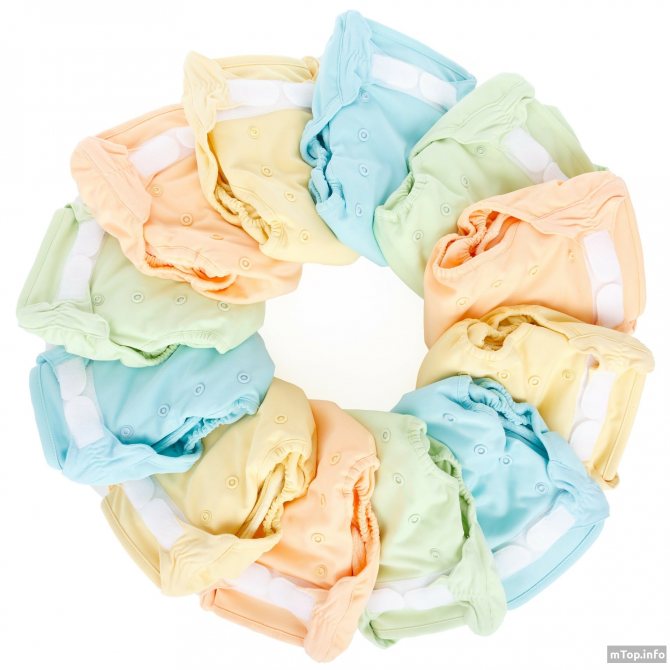
The absorbent liner is attached to the inner layer and takes on the function of absorbing all the baby's waste. The following materials are used for it:
- Bio gauze, flannel. These fabrics easily absorb moisture and are washed.
- Bamboo. Sold in the form of diapers, which every mother can fold as she pleases. It absorbs moisture and remains almost completely dry, without causing discomfort to the child.
- Microfiber. It is not a natural material, it is soft to the touch and does not cause allergies.
Sometimes manufacturers use liners made of combined materials, where the top layer is made of gauze and the bottom layer is made of bamboo.
